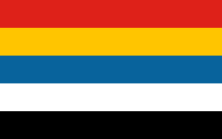Beiyang Government
“”China is so tired of being
|
| — |
The Beiyang government was the internationally recognized government of the ![]() Republic of China between 1912 and 1928, based in
Republic of China between 1912 and 1928, based in ![]() Beijing. He was dominated by the generals of the
Beijing. He was dominated by the generals of the ![]() Beiyang Army, giving him his name.
Beiyang Army, giving him his name.
Dispite the name suggesting that Beiyang was a ![]() centralized government with control over all China, the government was heavily influenced by
centralized government with control over all China, the government was heavily influenced by ![]() regional warlords, leading to a lack of effective central governance and contributing to widespread
regional warlords, leading to a lack of effective central governance and contributing to widespread ![]() corruption. Different factions often competed and warred for legitmency.
corruption. Different factions often competed and warred for legitmency.
History
On 10 March 1912, ![]() Yuan Shikai, leader of the
Yuan Shikai, leader of the ![]() Beiyang Army, became provisional president while located in
Beiyang Army, became provisional president while located in ![]() Beijing, his power base. He refused to move to
Beijing, his power base. He refused to move to ![]() Nanjing, fearing further assassination attempts. It was also more economical to keep the existing
Nanjing, fearing further assassination attempts. It was also more economical to keep the existing ![]() Qing bureaucracy in Beijing, so the provisional senate moved north as well; the government thereby began the administration from Beijing on 10 October 1912.
Qing bureaucracy in Beijing, so the provisional senate moved north as well; the government thereby began the administration from Beijing on 10 October 1912.
On the second year of the Republic of China (1913), October 6, Yuan Shikai was elected as the first president of the ![]() Republic of China, marking the official establishment of the Beijing government and the end of the
Republic of China, marking the official establishment of the Beijing government and the end of the ![]() provisional government. Also in 1913, the
provisional government. Also in 1913, the ![]() southern provinces revolted against Beiyang and Yuan in what's known as the "Second Revolution", however it failed.
southern provinces revolted against Beiyang and Yuan in what's known as the "Second Revolution", however it failed.
In 1915, Yuan Shikai tried to restore the ![]() monarchy by founding the
monarchy by founding the ![]() Empire of China, but this failed quickly because the people just got rid of a monarchy and weren't ready to have another one. So in 1916 the Empire of China collapsed and China broke into several cliques and armies ruled by warlords, most of them loyal to the Beiyang Government. From this until "reunification" was known as the Warlord Era. Beiyang also tried to create a national army, but the
Empire of China, but this failed quickly because the people just got rid of a monarchy and weren't ready to have another one. So in 1916 the Empire of China collapsed and China broke into several cliques and armies ruled by warlords, most of them loyal to the Beiyang Government. From this until "reunification" was known as the Warlord Era. Beiyang also tried to create a national army, but the ![]() southerners were distrustful to Beiyang, and no progress was made on this issue.
southerners were distrustful to Beiyang, and no progress was made on this issue.
Some factions were opposed to joining WWI, but still in the end Beiyang government declared war on the ![]() Central Powers in August 1917 and began sending
Central Powers in August 1917 and began sending ![]() labor battalions to
labor battalions to ![]() France and a token force to
France and a token force to ![]() Siberia.
Siberia. ![]() Duan Qirui, the premier of the Beiyang government (had only de-facto control over Northern China) got huge loans from
Duan Qirui, the premier of the Beiyang government (had only de-facto control over Northern China) got huge loans from ![]() Japan, claiming to build an army of a million men to send to Europe to fight. His rivals, however, knew that this army would not be leaving the country and would be used to crush dissent.
Japan, claiming to build an army of a million men to send to Europe to fight. His rivals, however, knew that this army would not be leaving the country and would be used to crush dissent.
By the 1920s, what was left of the Beiyang government has completely collapsed, and Beiyang now exists in name only. Warlords now owned the land that was once controlled by Beiyang, and different factions fought against each other. China was in complete chaos. In 1920, the cliques of ![]() Zhili and
Zhili and ![]() Anhui warred for control over the Beiyang government. Zhili, allied with the
Anhui warred for control over the Beiyang government. Zhili, allied with the ![]() Fengtian Clique, won after a little more than a week and destroyed the Anhui Clique. The
Fengtian Clique, won after a little more than a week and destroyed the Anhui Clique. The ![]() Beiyang Army was now permanently broken up. Zhili and Fengtian ruled most of China as the de-facto Beiyang government together until the First Zhili-Fengtian War in 1922.
Beiyang Army was now permanently broken up. Zhili and Fengtian ruled most of China as the de-facto Beiyang government together until the First Zhili-Fengtian War in 1922.
In 1921, the ![]() Nationalist government was established, serving as an opposition to the Beiyang government for the control of China.
Nationalist government was established, serving as an opposition to the Beiyang government for the control of China.
MORE WIP
Relationships
Friends
 Empire of Japan - Supported me against
Empire of Japan - Supported me against  these revolutionaries
these revolutionaries  .
.
Enemies
 Nationalist Government - You think you’ve won, don’t you? You call yourself the true heir of the Republic, but I was here first. It was MY armies that held China together after the fall of the
Nationalist Government - You think you’ve won, don’t you? You call yourself the true heir of the Republic, but I was here first. It was MY armies that held China together after the fall of the  Qing! Without me, you would have been nothing more than a band of idealists preaching revolution in the south.
Qing! Without me, you would have been nothing more than a band of idealists preaching revolution in the south.
Trivia
- Many people confuse the Beiyang flag as a
 LGBTQ+ flag, even though the Beiyang flag was made way before the LGBT movement solidified.
LGBTQ+ flag, even though the Beiyang flag was made way before the LGBT movement solidified. - Some presidents of the Beiyang Government lasted only a few weeks before being kicked out by the next warlord.
Flag
The flag that the Beiyang government used is called "Five Races Under One Union", with the red representing the ![]() Han Chinese, yellow the
Han Chinese, yellow the ![]() Manchus, blue the
Manchus, blue the ![]() Mongols, white the
Mongols, white the ![]() Hui Muslims (later is also represented
Hui Muslims (later is also represented ![]() Uyghurs and all other Muslim minorities), and black the
Uyghurs and all other Muslim minorities), and black the ![]() Tibetans. This set of symbolism would later be adopted by
Tibetans. This set of symbolism would later be adopted by ![]() Manchukuo, who changed it up a bit.
Manchukuo, who changed it up a bit.
Despite the Xinhai uprising targeting a Manchu-dominated regime, the flag and its supporters unanimously advocated racial integration. They promoted a view of the non-![]() Han ethnicities as also being Chinese, despite them being a relatively small percentage of the population.
Han ethnicities as also being Chinese, despite them being a relatively small percentage of the population.
How to draw

Beiyang Government has a drawing rating of easy.
- Draw a ball.
- Divide the ball into five stripes horizontally.
- Fill in these colours for the stripes from top to bottom: red, yellow, blue, white, black.
- Add Chinese eyes and done!
| Color Name | HEX | |
|---|---|---|
| Red | #DE2119 | |
| Yellow | #FFC500 | |
| Blue | #08639C | |
| White | #FFFFFF | |
| Black | #000000 | |





